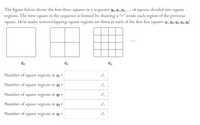
Advanced Engineering Mathematics
10th Edition
ISBN: 9780470458365
Author: Erwin Kreyszig
Publisher: Wiley, John & Sons, Incorporated
expand_more
expand_more
format_list_bulleted
Question
thumb_up100%

Transcribed Image Text:The figure below shows the first three squares in a sequence \( q_0, q_1, q_2, \ldots \) of squares divided into square regions. The next square in the sequence is formed by drawing a "+" inside each region of the previous square. How many nonoverlapping square regions are there in each of the first five squares \( q_1, q_2, q_3, q_4, q_5 \)?
The sequence starts with:
- \( q_0 \): A single square.
- \( q_1 \): A square divided into 4 smaller squares (2 rows and 2 columns).
- \( q_2 \): A square divided into 16 smaller squares (4 rows and 4 columns).
The sequence continues, with each subsequent square having its regions divided by drawing a "+" inside each region of the previous square.
Fill in the blanks for the number of nonoverlapping square regions:
- Number of square regions in \( q_1 = \)
- Number of square regions in \( q_2 = \)
- Number of square regions in \( q_3 = \)
- Number of square regions in \( q_4 = \)
- Number of square regions in \( q_5 = \)
Expert Solution
This question has been solved!
Explore an expertly crafted, step-by-step solution for a thorough understanding of key concepts.
This is a popular solution
Trending nowThis is a popular solution!
Step by stepSolved in 2 steps with 2 images

Knowledge Booster
Similar questions
- How many distinct 5-letter words can be formed using the letters from the word "MATHS" if repetition of letters is not allowed?arrow_forwardFind the number of positive integers not exceeding 1020 that are not divisible by 3, 17, or 35.arrow_forwardHow many 4-digit numbers are there that are divisible by 10 and the sum of whose digits is 10?arrow_forward
arrow_back_ios
arrow_forward_ios
Recommended textbooks for you
 Advanced Engineering MathematicsAdvanced MathISBN:9780470458365Author:Erwin KreyszigPublisher:Wiley, John & Sons, Incorporated
Advanced Engineering MathematicsAdvanced MathISBN:9780470458365Author:Erwin KreyszigPublisher:Wiley, John & Sons, Incorporated Numerical Methods for EngineersAdvanced MathISBN:9780073397924Author:Steven C. Chapra Dr., Raymond P. CanalePublisher:McGraw-Hill Education
Numerical Methods for EngineersAdvanced MathISBN:9780073397924Author:Steven C. Chapra Dr., Raymond P. CanalePublisher:McGraw-Hill Education Introductory Mathematics for Engineering Applicat...Advanced MathISBN:9781118141809Author:Nathan KlingbeilPublisher:WILEY
Introductory Mathematics for Engineering Applicat...Advanced MathISBN:9781118141809Author:Nathan KlingbeilPublisher:WILEY Mathematics For Machine TechnologyAdvanced MathISBN:9781337798310Author:Peterson, John.Publisher:Cengage Learning,
Mathematics For Machine TechnologyAdvanced MathISBN:9781337798310Author:Peterson, John.Publisher:Cengage Learning,


Advanced Engineering Mathematics
Advanced Math
ISBN:9780470458365
Author:Erwin Kreyszig
Publisher:Wiley, John & Sons, Incorporated

Numerical Methods for Engineers
Advanced Math
ISBN:9780073397924
Author:Steven C. Chapra Dr., Raymond P. Canale
Publisher:McGraw-Hill Education

Introductory Mathematics for Engineering Applicat...
Advanced Math
ISBN:9781118141809
Author:Nathan Klingbeil
Publisher:WILEY

Mathematics For Machine Technology
Advanced Math
ISBN:9781337798310
Author:Peterson, John.
Publisher:Cengage Learning,

